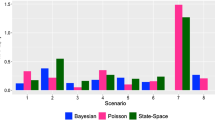Abstract
A set of epidemiological models and their basic reproductive numbers are presented. For some models, the expression of the basic reproductive number can be very complex to determine. In this work, we present some techniques to find the expressions of these basic reproductive numbers starting from submodels of the original one. Some particular models with their respective \(R_0\), which can be applied to the study of some important diseases, are also presented.











Similar content being viewed by others
References
Soupios, M.A.: Impact of the plague in Ancient Greece. Infect. Dis. Clin. N. Am. 18, 45–51 (2004)
Eastman, J.T.: The making of a pandemic: bubonic plague in the 14th century. J. Lanc. Gen. Hosp. 4(1), 10–17 (2009)
Taubenberger, J.K., Morens, D.M.: 1918 Influenza: the mother of all pandemics. Emerg. Infect. Dis. 12, 15–22 (2006)
Diekmann, O., Heesterbeek, J.A.P., Metz, J.A.J.: On the definition and the computation of the basic reproduction ratio \(R_0\) in models for infectious diseases in heterogeneous populations. J. Math. Biol. 28, 365–382 (1990)
Diekmann, O., Heesterbeek, J.A.P., Roberts, M.G.: The construction of next-generation matrices for compartmental epidemic models. J. R. Soc. Interface 7, 873885 (2009)
Li, J., Blakeley, D., Smith, R.J.: The failure of \(R_0\). Comput. Math. Methods Med. 2011, 527610 1-11 (2011)
Baca-Carrasco, D., Olmos, D., Barradas, I.: A mathematical model for human and animals leptospirosis. J. Biol. Syst. (2013)
Crowford, B., Kribs-Zaleta, C.: A metapopulation model for sylvatic T. cruzi transmission with vector migration. Math. Biosci. Eng. 11, 471–509 (2014)
Gantmacher, F.R.: The Theory of Matrices, vol. 1. Chelsea Publishing Company, New York (1960)
Feng, Z., Velasco-Hernndez, J.X.: Competitive exclusion in a vector-host model for the dengue fever. J. Math. Biol. 35, 523–544 (1997)
Castillo-Chavez, C., Feng, Z., Huang, W.: On the computation of \(R_0\) and its role on global stability. In: Castillo-Chavez, C., Blower, S., van den Driessche, P., Kirschner, D., Yakubu, A.-A. (eds.) Mathematical Approaches for Emerging and Reemerging Infectious Diseases: An Introduction, pp. 229–250. Springer, New York (2002)
van den Driessche, P., Watmough, J.: Reproduction numbers and sub-threshold endemic equilibria for compartmental models of disease transmission. Math. Biosci. 180, 29–48 (2002)
Heffernan, J.M., Smith, R.J., Wahl, L.M.: Perspectives on the basic reproductive ratio. J. R. Soc. Interface 2, 281–293 (2005)
Jones, J.H.: Notes On \(R_0\). Stanford University, Stanford (2007)
van den Driessche, P., Watmough, J.: Further notes on the basic reproduction number in Mathematical Epidemiology. In: Brauer, F., van den Driessche, P., Wu, J. (eds.) Mathematical Epidemiology, pp. 159–178. Springer, Berlin (2008)
Acknowledgments
The authors would like to knowledge the referees for their valuable and useful comments that helped greatly to improve the presentation of this manuscript. This work was supported by The National Council of Science and Technology in México (CONACyT) under Grant 177493.
Author information
Authors and Affiliations
Corresponding author
Appendix
Appendix
Next-Generation Matrix and Its Characteristic Polynomial
We constructed the next-generation matrix for the system (7), following the technique in [12–15]. Such matrix is given by
where \((I_{10},I_{20},I_{30})=(0,0,0)\) is the free disease equilibrium. To facilitate the writing, we use \(({\mathcal {V}}_1,{\mathcal {V}}_2,{\mathcal {V}}_3)\) instead of \(({\mathcal {V}}_1(I_{10}),{\mathcal {V}}_2(I_{20}),{\mathcal {V}}_3(I_{30}))\). Then the characteristic polynomial of the K is
where
are the basic reproductive numbers of independent cycles of the system (7).
Observe that the coefficients in \(P(\lambda )\) are completely related. The coefficient of the quadratic term is the sum of the \(R_0\)’s of all the 1-cycles involved. The coefficient of the linear term has the sum of the \(R_0\)’s of all the 2-cycles raised to the square, minus the total sum of the products of the \(R_0\)’s of the 1-cycles of the system. Finally, the constant term is the sum of the \(R_0\)’s of the 3-cycles raised to the cube, minus the products of 2-cycles raised to the square with 1-cycles.
This structure of \(P(\lambda )\), becomes very useful in order to study subsystems of system (7). Clearly, in order to obtain the characteristic polynomial of any subsystem of (7), what proceeds is to take as zero the \(R_0\)’s of the cycles that are not present in the subsystem.
In order to prove Lemmas 1–5 and Theorems 1 and 2, it is necessary to find the largest eigenvalue of the associated next-generation matrix (19), which in turn is the largest root in norm of the characteristic polynomial \(P(\lambda )\). Because the next-generation matrix is non negative, from the Perron–Frobenius theorem, the spectral radius of it is real and positive [9]. As \(P(\lambda )\) is of degree three, it was possible to find the roots explicitly using Maple. In the most difficult case, two of the roots were complex and one real, the latter being \(R_0\).
For example, for Lemma 1, the characteristic polynomial is
and the roots are \(\lambda _1=0\), \(\lambda _2=-\sqrt{R_i^2+R_j^2}\) and \(\lambda _3=\sqrt{R_i^2+R_j^2}\). Therefore the basic reproductive number is \(\lambda _3\).
Similarly, we proceed to the proofs of the others lemmas and theorems.
Rights and permissions
About this article
Cite this article
Olmos, D., Barradas, I. & Baca-Carrasco, D. On the Calculation of \(R_0\) Using Submodels. Differ Equ Dyn Syst 25, 481–497 (2017). https://doi.org/10.1007/s12591-015-0257-7
Published:
Issue Date:
DOI: https://doi.org/10.1007/s12591-015-0257-7




